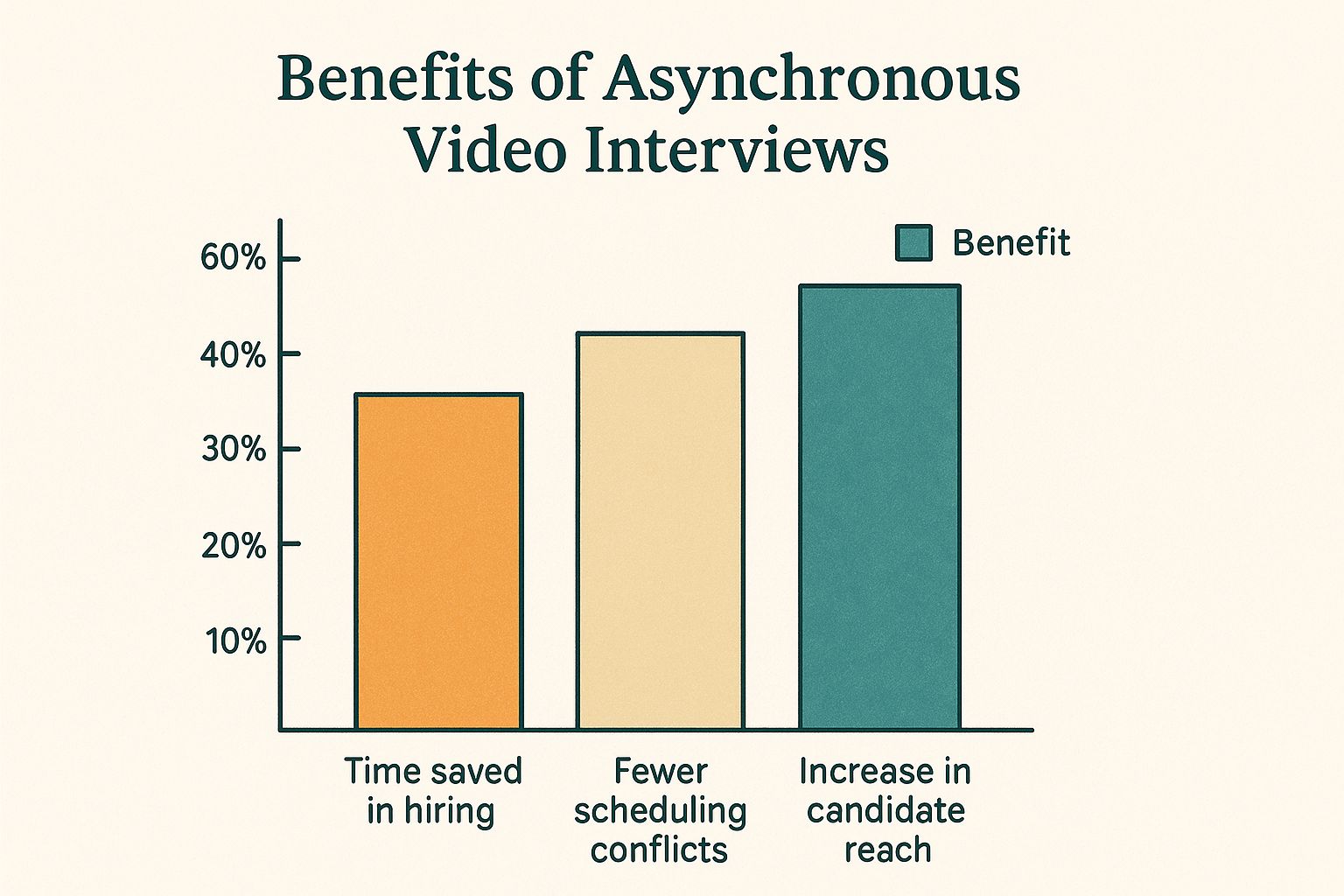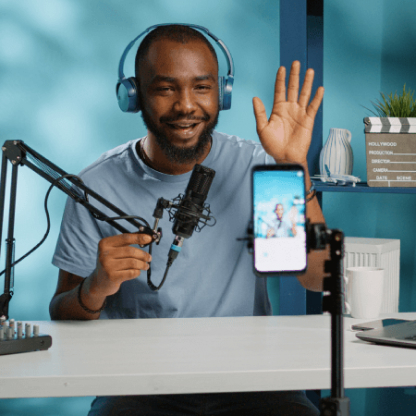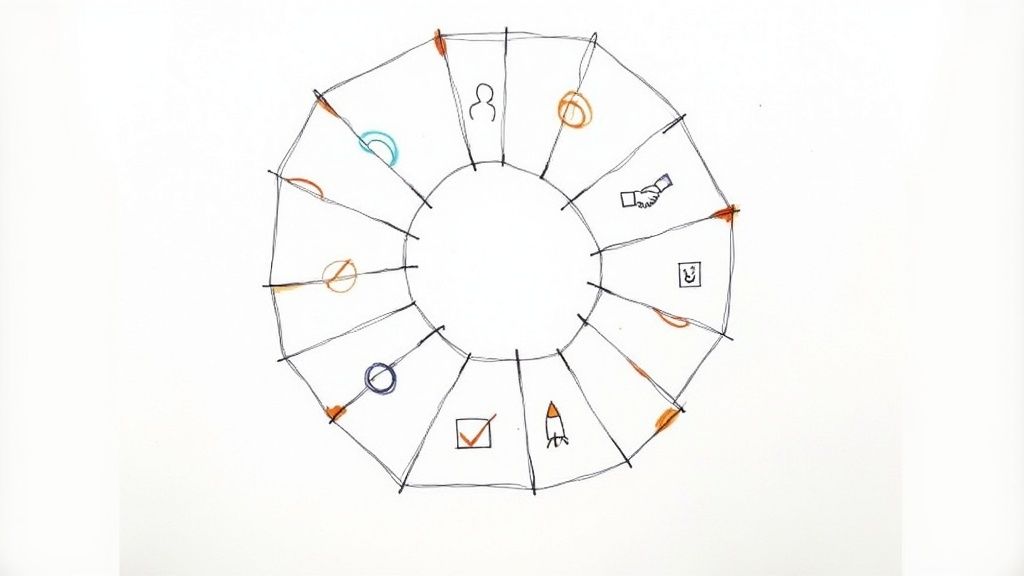Think about the last time you tried to schedule a simple 30-minute call with someone in another time zone. The back-and-forth emails, the calendar gymnastics, the constant refreshing to see if they've accepted the invite… it's exhausting.
For most hiring managers, this isn't just a minor annoyance; it’s a full-time, soul-crushing game of time zone Tetris. You spend days just to lock in an initial chat, burning out your team and creating a bottleneck that brings hiring—and company growth—to a crawl.
This isn't strategic recruiting; it's glorified admin work. And it’s precisely this scheduling chaos that asynchronous video interviews were designed to obliterate.
Escaping the Hell of Interview Scheduling
Let’s get straight to it. An asynchronous video interview is a one-way screening process. You, the recruiter, send a set of questions, and candidates record their answers on their own time.
That's it. No live conversation, no calendar conflicts, no awkward "can you hear me now?" moments. Think of it less like a live meeting and more like a video voicemail system built for hiring. It’s a pragmatic escape route from the scheduling nightmare that plagues modern recruiting.

What Are They, Really?
This isn’t just some tech trend; it's quickly becoming the standard for the first step in the hiring funnel. Why? Because it just works. By 2025, an estimated 70% of companies are expected to be using some form of video screening, with most leaning into asynchronous formats.
The numbers don't lie. Companies that make the switch report a 50% reduction in time-to-hire and a 30% drop in recruitment costs. They're reclaiming dozens of hours that were once lost to the black hole of scheduling.
The core benefits are brutally simple:
- You get time back in your day. Your team can review submissions when it actually works for them, not just when a candidate happens to be free.
- You get access to a wider talent pool. Time zones become totally irrelevant. You can screen top candidates from London to Los Angeles without forcing anyone to wake up at 5 a.m. for a call.
- You get consistency in your evaluations. Every single candidate answers the exact same questions in the same format. This helps remove the "off-day" variable that can skew results in live calls.
The real magic is that you stop interviewing one-by-one and start screening in parallel. While you’re in a meeting, ten candidates could be completing their initial interview.
This approach isn't about removing the human element. It's about saving it for the candidates who truly matter. You can dive deeper into this concept with our guide on how automated interview scheduling can improve your hiring process. It’s time to get your team’s sanity back so they can focus on what they do best: building relationships with top contenders, not just booking calls with everyone who applies.
How Your Hiring Process Is Quietly Bleeding Money
Think your hiring budget is just about recruiter salaries and job board fees? Cute. The real cost—the one that never shows up on a spreadsheet—is hidden in the hours your team wastes playing calendar Tetris and conducting repetitive, low-value phone screens.
Hope you enjoy spending your afternoons fact-checking resumes and running the same 15-minute introductory call on a loop—because that’s now your senior team’s full-time job.
This is the wake-up call your CFO has been waiting for. We’re going to break down the ROI of asynchronous video interviews in terms anyone holding a budget can appreciate. Forget the fluffy benefits; we're talking about a fundamental shift in how you allocate your most valuable asset: your team's time.
The True Cost of a "Quick Chat"
That "quick 30-minute chat" isn't 30 minutes. It's the 15 minutes your hiring manager spends prepping, the 30 minutes on the call, the 15 minutes writing up notes, and the hour of lost focus trying to get back into deep work. All told, that’s nearly two hours of high-value employee time spent on a single top-of-funnel candidate who might not even be a fit.
Multiply that by 20 candidates for just one role. You just burned a full work week.
The return on investment here isn’t a small, incremental gain; it's a massive, measurable leap in efficiency. It's common for organizations to see a 50-70% reduction in screening time and a 30-40% decrease in the overall cost-per-hire. The structured nature of these interviews also drives a 25-35% improvement in quality of hire because you're forced to evaluate everyone against the same objective criteria, not just who you vibed with on a Tuesday morning. And because stakeholders can review and score submissions on their own time, teams report an 80% increase in collaboration.
This infographic really puts the immediate impact into perspective.

As the data shows, it's not just about saving time. It’s about fundamentally changing the dynamics of scheduling and talent access, making your entire process more robust and far-reaching.
The Hidden Costs of Traditional Screening vs Asynchronous Interviews
Let's lay it out, no fluff. This table shows where your time and money are really going when you stick with old-school phone screens versus making the switch.
| Metric | Traditional Phone Screens | Asynchronous Video Interviews |
|---|---|---|
| Scheduling Time | Hours of back-and-forth emails | Zero. Candidates record on their time. |
| Hiring Manager Time | 1-2 hours per candidate (prep, call, notes) | 5-10 minutes per candidate (reviewing) |
| Candidate Pool Size | Limited by interviewer availability & time zones | Global. Unrestricted by schedules. |
| Consistency | Varies wildly by interviewer and their mood | 100% consistent questions for every candidate |
| Collaboration | Difficult; relies on second-hand notes | Easy; share links for direct review |
| Bias Potential | High; susceptible to first impressions and rapport | Reduced; focus is on the substance of answers |
The numbers don't lie. One path burns through your team's most valuable hours on administrative tasks, while the other protects their focus for the work that actually matters.
Reclaiming Your Team's Focus
Let's be brutally honest for a second. Most initial phone screens are a waste of your best people's talent. You’re using senior engineers, product leads, and department heads to ask questions a well-designed form could handle.
It’s like using a world-class surgeon to apply bandages.
When you switch to an asynchronous first step, you stop the bleeding. You redirect those precious hours from administrative drudgery back to the strategic work that actually drives the business forward.
Your best people should spend their time closing top candidates, not screening unqualified ones. Asynchronous interviews act as a powerful, automated filter that protects your team's focus.
Instead of a scattered, reactionary process, your hiring pipeline becomes a well-oiled machine. Your team can review candidates in focused blocks of time, comparing apples to apples and making decisions based on substance, not scheduling convenience. This leads to a faster, cheaper, and more consistent process. If you want to dive deeper, we have a whole guide on how to reduce recruitment costs with smarter strategies.
The Compounding Value of Consistency
The financial benefits don't stop at just saving time. One of the quietest killers of hiring ROI is inconsistency. When different interviewers ask different questions, you introduce bias and make it impossible to compare candidates objectively.
Person A gets the easy questions from a friendly interviewer. Person B gets grilled by someone who’s having a bad day. Who gets the offer? Probably the one who got lucky.
Asynchronous video interviews eliminate this variable completely. Every single candidate for a given role answers the exact same questions, in the exact same format, under the same conditions. This enforces a level of fairness and rigor that frantic, back-to-back phone screens never could.
This consistency isn't just a "nice-to-have" for your diversity and inclusion goals; it's a direct driver of better hiring outcomes. You start making decisions based on merit and demonstrated skills, which leads to better hires, lower turnover, and a stronger team down the line. That’s an ROI that pays dividends long after the initial hire is made.
How to Implement This Without Scaring Off Candidates
So, you’re sold on the idea. You've seen the numbers, and you're ready to stop playing calendar Tetris just to schedule a few screening calls. But there’s that nagging voice in your head, isn’t there? The one whispering, “Won’t this feel… robotic? Am I going to scare off the best people?”
It’s a fair question. A poorly handled asynchronous interview is worse than no interview at all. It can make your company feel cold, impersonal, and frankly, a little demanding.
This isn’t about just flipping a switch on some new software. It’s about thoughtfully redesigning the very first impression your company makes. Let’s walk through the playbook for getting this right, based on our own hard-won lessons from the trenches.

The Intro Email: Your Anti-Anxiety Onboarding
Your first communication is everything. The goal here is to get candidates excited, not stressed out. Too many companies blow this with a cold, generic email that reads like a court summons. Don't be that company.
Your introductory email needs to nail three things:
- Explain the Why. Be transparent. Tell them you use this process to respect their time and give every single candidate a fair, consistent shot. Frame it as a benefit for them.
- Set Crystal-Clear Expectations. How long will it take? How many questions are there? When is it due? Leave absolutely no room for guesswork.
- Provide a Human Touch. This is the secret sauce. Include a short, friendly video from the hiring manager. A simple 30-second clip saying, "Hey, I'm Sarah, the hiring manager for this role. We're really excited to learn more about you!" makes a world of difference.
This isn’t just about sending instructions; it's about selling them on your process and your culture from the very first click.
Crafting Questions That Actually Reveal Talent
The biggest mistake I see teams make is just copy-pasting their phone screen questions into a video format. That's just lazy, and it doesn't work. You need questions specifically designed for this medium.
Good async video questions aren’t about trivia or "gotcha" moments. They are prompts designed to invite storytelling and show you how a candidate thinks.
Don't ask questions that a candidate can answer with a quick Google search. Ask questions that force them to pull from real-world experience. You're looking for substance, not a perfect on-camera delivery.
Here’s a simple framework to get you started:
- Situational Questions: "Imagine we just launched a new feature and the user feedback is overwhelmingly negative. What are the first three things you would do?"
- Behavioral Questions: "Tell me about a time you had to deliver a project on an impossibly tight deadline. How did you approach it, and what was the outcome?"
- Passion Questions: "What's a project you worked on, outside of your job, just because you were curious about it?"
These kinds of prompts give candidates a real chance to shine and show off their problem-solving skills, not just their public speaking ability. For more ideas, our deep dive on the pre-recorded video interview has a ton of specific examples.
The Logistics: Setting the Right Rules of the Road
Now for the nuts and bolts. How you configure the interview settings can make or break the candidate experience. Get this part wrong, and you’ll create a ton of unnecessary stress.
Here are our non-negotiable rules, learned the hard way:
- Thinking Time: Give them at least 30-60 seconds of prep time before the recording starts for each question. No one likes being ambushed, even by a recording.
- Time Limits: Be generous. A 2-3 minute limit per answer is usually perfect. It encourages concise answers without feeling like a frantic race against the clock.
- Re-records: Always, always allow at least one re-record. We're all human. People stumble over their words or get interrupted by a barking dog. Giving them a second take shows empathy and dials down the anxiety.
- Support: Make it painfully obvious how candidates can get technical help if they run into trouble. A simple link to a help doc or a support email is crucial.
To help your candidates feel comfortable and produce their best work, consider pointing them to resources on effective video recording techniques. A little guidance can go a long way in leveling the playing field, helping them focus on their answers, not the technology.
Ultimately, the goal is to create a process that feels fair, thoughtful, and human. When you nail this, candidates don’t see it as a robotic hurdle; they see a modern, efficient process from a company that respects their time. And that’s a first impression worth making.
The Good, The Bad, and The Awkward
Alright, let's get real. Anyone who tells you that asynchronous video interviews are a flawless silver bullet for all your hiring woes is either selling you something or has never actually used them in the trenches. They are incredibly powerful, yes. But like any tool, they have their sharp edges. This isn't the sales pitch; this is the unvarnished truth.
We’ve seen it all—from the game-changing hires we never would have found otherwise to the candidates who looked like they were recording a hostage video. Let’s break down what you’re really signing up for.

The Good: It’s Really, Really Good
The upside is exactly what you’ve heard, and it’s massive. The biggest win? You immediately obliterate scheduling conflicts and time zone headaches. You stop being a glorified administrative assistant and start being a recruiter again.
This flexibility genuinely transforms the entire game. Candidates can record answers when they’re at their best—whether that's 10 PM on a Wednesday or 6 AM on a Saturday—not just when you have a 30-minute slot open. This simple shift dramatically expands your talent pool, giving you access to candidates you’d otherwise miss and allowing your team to review submissions in focused, productive blocks.
The single greatest benefit? You can screen ten candidates in the time it used to take you to schedule one. It’s a force multiplier for a lean hiring team.
Plus, the inherent structure forces a level of fairness that's almost impossible to achieve in back-to-back phone screens. Every candidate gets the exact same questions in the exact same format. This levels the playing field and gives you a much cleaner signal on who is actually qualified.
The Bad: The Stuff No One Talks About
Now for the downsides. The most obvious one is that you lose the spontaneous back-and-forth of a live conversation. You can’t ask a follow-up question in the moment or dig deeper into an interesting but incomplete answer. It’s a monologue, not a dialogue.
This means you have to be exceptionally good at writing your initial questions. If your prompts are lazy, your answers will be useless. Garbage in, garbage out.
Then there's the "on-camera" problem. Some absolutely brilliant people—engineers, analysts, creatives—are just not great on camera. They freeze up, get nervous, and deliver stiff, awkward responses that don't reflect their true abilities. Are you willing to potentially lose a great candidate because they aren’t a natural performer? It’s a real risk you have to mitigate with smart evaluation rubrics that focus purely on the substance of the answer, not the delivery.
The Awkward: The Unavoidable Cringe
And finally, we have the awkward. Oh, the awkward. You will see things you can’t unsee.
- The Technical Glitches: Someone’s microphone will sound like they’re recording from inside a wind tunnel. Another’s video will freeze on a terrifyingly unflattering facial expression. It’s just going to happen.
- The Questionable Backgrounds: Yes, you will see messy bedrooms. You’ll see candidates recording from their cars in a parking lot. You will see wandering pets and surprise appearances from roommates.
- The Over-Rehearsed Candidate: You’ll get responses that sound like they were written by a PR team and memorized for a week. They are polished, perfect, and tell you absolutely nothing about how the person actually thinks on their feet.
When it comes to visual presentation, a professional background can make a huge difference in how a candidate is perceived. For anyone looking to improve their setup, there are some excellent tips for creating a professional background that are easily adaptable for video interviews.
So, is it worth it? Absolutely, but you have to go in with your eyes wide open. You need a process that maximizes the incredible efficiency gains while actively working to minimize the very real downsides. You need to train your team to look past the awkwardness and focus on the signal, not the noise. It’s a tool, not a magic wand, and learning how to wield it properly is what separates the frustrated teams from the ones who are hiring ten times faster.
How to Pick a Platform (Without Getting Ripped Off)
So, you’re ready to stop lighting your team’s time on fire. Good. The problem is, the market for these video interview platforms is a jungle of buzzwords, bloated feature lists, and sales reps promising you the moon.
How do you pick one without having to mortgage the office ping-pong table for a tool that just ends up creating new headaches?
Let’s cut through the noise. I’ve demoed more of these things than I care to admit, and I’ve learned that most of the flashy, “enterprise-grade” features are just shiny objects designed to pad the invoice. What you really need is a tool that does a few things exceptionally well, not a Swiss Army knife that’s mediocre at everything.
The Non-Negotiable Features You Actually Need
Forget the AI sentiment analysis and virtual reality candidate lounges for a second. Let's talk about the features that will actually save you from wanting to throw your laptop out a window on a Tuesday afternoon.
- Seamless ATS Integration: This is the big one. If the platform doesn’t talk to your Applicant Tracking System, walk away. Seriously. The entire point is to reduce administrative work, not create a new data-entry job for someone on your team.
- Customizable Branding: You’ve spent years building your brand. The last thing you want is for candidates to land on a generic, third-party page that looks like a tax form. Your logo, your colors, your voice—the experience should feel like your process from start to finish.
- Collaborative Review Tools: Hiring is a team sport. Your platform needs to make it dead simple for multiple people to watch, score, and leave comments on interviews. If your team has to resort to sharing links in a chaotic Slack channel, the tool has already failed you.
These three things are the foundation. If a platform doesn't nail them, nothing else it offers matters. It’s like buying a sports car with a terrible engine; it looks great parked in the driveway, but it won’t actually get you anywhere.
Decoding the Pricing Games
Now for the fun part: the pricing models. Vendors have gotten creative here, and not always in a good way. You’ll generally run into two main types, each with its own trap.
First up is the pay-per-candidate or pay-per-interview model. This sounds fantastic when you’re just starting out. "Only pay for what you use!" they'll chirp. But what happens when you post a role that gets 300 applicants? Suddenly, that "affordable" solution costs you more than a month’s rent. It’s a model that literally punishes you for success.
Then you have the big, scary enterprise subscription. This gives you unlimited everything, but the price tag is designed for a Fortune 500 company, not a growing business. They’ll try to lock you into an annual contract that feels more like a hostage situation, packed with features you’ll never even touch.
Your goal is to find the middle ground: a predictable, flat-rate subscription that scales with your team, not your applicant volume. You want unlimited jobs and unlimited users so you never have to think twice about using the tool.
The $500 Hello
Here’s a dirty little secret: many platforms will charge you extra just for basic setup and support. They call it "onboarding" or a "success package," but what it really is is a fee to get the product to do what it was supposed to do in the first place.
Don't fall for it. A good platform should be intuitive enough for you to set up yourself in minutes. If you need a certified consultant and a week of training just to post your first job opening, the product is just too complicated.
Look for a vendor that offers a free trial—not a canned demo, but a real trial where you can get your hands dirty. And make sure their support is included, not a pricey add-on. A company's success should be tied to your success, not treated as a line item on the invoice. (Toot, toot! This is exactly why we built Async Interview the way we did.)
Choosing the right platform isn’t just a software decision; it's a strategic one that will define your hiring efficiency for years to come. Choose wisely.
So, What's the Final Verdict?
We’ve walked through the what, the why, and the how. We've looked at the good, the bad, and the just plain awkward parts of asynchronous video interviews. Now it’s time to make a call.
Let’s be direct here. This isn’t a wishy-washy summary. This is my honest take after seeing this play out time and time again.
For most companies that are trying to grow, the real question isn't if you should switch to asynchronous video interviews. It's how fast you can get the old way of doing things out the door. Sticking with manual phone screens today is like clinging to a flip phone in a world of smartphones. Yes, it technically still makes calls, but you're falling behind everyone else, and you know it.
Why Waiting Is the New Losing
Let's just quickly run through the core arguments again, because they're pretty hard to ignore. When you adopt this, you aren't just buying another piece of software; you're buying back your team's most precious resource: time.
The numbers don't lie. Companies are seeing a 50-70% reduction in the time it takes to screen candidates. That’s hundreds, maybe thousands, of hours a year your best people get back to focus on work that actually matters, instead of getting bogged down in scheduling hell.
Then, there’s the money. We're talking about a serious drop in hiring costs—not just from the hours you save, but from making better, more consistent hires who actually stick around. In a world where top talent is spread across the globe, locking yourself into a process that depends on matching up time zones is just shooting yourself in the foot.
The bottom line is simple: asynchronous video interviews bring a level of discipline, consistency, and raw efficiency that manual screening just can't touch. It’s a massive competitive advantage hiding right in front of you.
Your Competitors Aren't Going to Wait for You
Still not sure? Let me leave you with one final thought.
While you're tangled up in yet another endless email chain trying to nail down a 30-minute call, your competitors are already reviewing dozens of qualified candidates. They're moving faster, they're more organized, and they're reaching a much bigger talent pool.
Plain and simple, they're building a better team, faster than you are. All because they embraced a smarter way to work.
Making this change isn't just about being more efficient; it's about staying in the game. Moving to an asynchronous model shifts you from a reactive scheduler to a proactive talent magnet. You stop just filling seats and start building an engine for real growth.
The only question left is, can you really afford not to?
Frequently Asked Questions
Alright, let's tackle a few of the common questions we hear all the time. No fluff, just the straight answers from someone who's seen this go right—and very, very wrong.
Do Asynchronous Video Interviews Create a Bad Candidate Experience?
They absolutely can, if you’re lazy about it. A bad experience usually comes from a lack of transparency, unrealistic time limits, or a cold, robotic process that feels like an interrogation. Hope you enjoy alienating top talent, because that’s what you’ll get.
The key is to over-communicate. Explain why you're using asynchronous video interviews (to give every candidate a fair shot and respect their time), provide dead-simple instructions, offer technical support, and for the love of everything, allow at least one re-record. When done thoughtfully, we’ve found many candidates actually prefer the flexibility to record when they feel most prepared.
Are These Interviews Biased Against Candidates Who Aren’t Good on Camera?
This is a totally valid concern. You're not hiring news anchors (unless you are, in which case, carry on). The solution isn't in the tech; it's in training your review team.
You need to create a simple, clear rubric that forces reviewers to focus on the substance of the answers, not the presentation. Explicitly tell your team to ignore factors like the candidate's background, their lighting, or how polished their on-camera delivery is.
The entire point of standardizing questions is to reduce bias. If you don't standardize the evaluation criteria to match, you’ve completely missed the point.
How Do You Evaluate Soft Skills Without a Live Conversation?
You have to be more deliberate with your questions. Stop asking generic, useless prompts like "Are you a team player?" and start using situational or behavioral questions that require actual thought.
For example, instead of asking about teamwork, try this: "Tell me about a time you had a significant disagreement with a colleague on a project. How did you handle it, and what was the outcome?"
Their storytelling, problem-solving approach, and self-awareness in that recorded answer will tell you far more about their real-world soft skills than a simple "yes" in a live call ever could. It separates the talkers from the doers.
Ready to stop wasting time and start hiring smarter? At Async Interview, we built the platform we always wished we had—simple, effective, and designed to get out of your way. See how you can start hiring up to 10x faster with a free trial of Async Interview.




